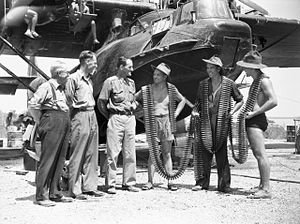No. 20 Squadron RAAF
| No. 20 Squadron RAAF | |
|---|---|

Personnel of No. 20 Squadron carrying machine-gun belts speak with members of the Parliamentary War Expenditure Committee in Darwin, Northern Territory, October 1944
|
|
| Active | 1941–46 2015–current |
| Country | Australia |
| Branch | Royal Australian Air Force |
| Role | Airfield support |
| Part of | No. 96 Wing, Combat Support Group |
| Garrison/HQ | RAAF Base Woomera |
| Engagements |
World War II |
| Insignia | |
| Squadron code | RB (1941–46) |
| Aircraft flown | |
| Patrol |
PBY Catalina (1941–46) Short Empire (1941–42) |
World War II
No. 20 Squadron is a Royal Australian Air Force (RAAF) support squadron. Coming under the control of No. 96 Wing, it is responsible for the management of the airfield at RAAF Base Woomera, South Australia. The squadron originated as a maritime patrol unit during World War II. Raised in August 1941, it operated PBY Catalina and Short Empire flying boats from bases in New Guinea, Queensland and the Northern Territory, conducting search-and-rescue, mine-laying, anti-submarine and bombing missions against Japanese targets in the Pacific theatre. Following the conclusion of hostilities, the squadron was disbanded in March 1946. It was reactivated as an airfield support squadron in April 2015.
No. 20 Squadron was formed at Port Moresby, New Guinea, on 1 August 1941 for a general reconnaissance role, under the command of Squadron Leader W.N. Gibson. Its establishment was six PBY Catalina flying boats and 133 personnel, but only five aircraft (all transferred from No. 11 Squadron) and 55 personnel were available initially. The squadron conducted long-range patrols between bases scattered around the islands to Australia's north in conjunction with No. 11 Squadron. On 18 November, No. 20 Squadron's Catalinas were augmented by two Short Empire flying boats transferred from No. 11 Squadron.
On 25 November 1941, following the loss of HMAS Sydney, one of No. 20 Squadron's Catalinas was despatched to Western Australia to join a No. 11 Squadron Catalina in search-and-rescue missions, but they found only oil slicks. By the outbreak of war in the Pacific, No. 20 Squadron had a strength of six Catalinas and two Empire flying boats. Its personnel at the beginning of December numbered 14 officers and 118 men. The squadron undertook its first sortie of the Pacific War on 8 December; a Catalina located three Japanese luggers in the vicinity of Thursday Island, Queensland. Later in the month it commenced anti-submarine patrols and, in January 1942, bombing raids against Japanese bases. As the Japanese advanced into the South West Pacific, No. 20 Squadron was also responsible for evacuating white civilians from areas threatened by invasion. On 21 January, one of its Catalinas located the Japanese fleet steaming for Rabaul and signalled a warning to the town's Australian defenders before being shot down by anti-aircraft fire; it was the squadron's first combat loss.
...
Wikipedia
